Histone H3 Mouse Monoclonal Antibody [3-C4]

cat.: EM30605
| Product Type: | Mouse monoclonal IgG1, primary antibodies |
|---|---|
| Species reactivity: | Human, Mouse, Rat |
| Applications: | WB, IHC-P, mIHC, IF-Tissue, ChIP |
| Clonality: | Monoclonal |
| Clone number: | 3-C4 |
| Form: | Liquid |
| Storage condition: | Shipped at 4℃. Store at +4℃ short term (1-2 weeks). It is recommended to aliquot into single-use upon delivery. Store at -20℃ long term. |
| Storage buffer: | 1*PBS (pH7.4), 0.2% BSA, 40% Glycerol. Preservative: 0.05% Sodium Azide. |
| Concentration: | 2ug/ul |
| Purification: | Protein A affinity purified. |
| Molecular weight: | Predicted band size: 15 kDa |
| Isotype: | IgG1 |
| Immunogen: | Synthetic peptide within C-terminal residues of human Histone H3. |
| Positive control: | HeLa cell lysate, A549 cell lysate, HT-29 cell lysate, HEK-293 cell lysate, C2C12 cell lysate, L-929 cell lysate, C6 cell lysate, mouse kidney, human liver tissue, human testis tissue, mouse testis tissue, rat testis tissue, rat brain tissue. |
| Subcellular location: | Nucleus. |
| Recommended Dilutions:
WB IHC-P mIHC IF-Tissue ChIP |
1:10,000 1:1,000-1:2,000 1:500 1:200-1:400 Use 0.5~2 μg for 25 μg of chromatin. |
| Uniprot #: | SwissProt: P68431 Human | P84243 Human | Q16695 Human | Q6NXT2 Human | Q71DI3 Human | P68433 Mouse | Q6LED0 Rat |
| Alternative names: | H3 histone family, member A H3/A H31_HUMAN H3FA Hist1h3a HIST1H3B HIST1H3C HIST1H3D HIST1H3E HIST1H3F HIST1H3G HIST1H3H HIST1H3I HIST1H3J histone 1, H3a Histone cluster 1, H3a Histone H3.1 Histone H3/a Histone H3/b Histone H3/c Histone H3/d Histone H3/f Histone H3/h Histone H3/i Histone H3/j Histone H3/k Histone H3/l |
Images

|
Fig1:
Western blot analysis of Histone H3 on different lysates with Mouse anti-Histone H3 antibody (EM30605) at 1/10,000 dilution. Lane 1: HeLa cell lysate Lane 2: A549 cell lysate Lane 3: HT-29 cell lysate Lane 4: HEK-293 cell lysate Lane 5: C2C12 cell lysate Lane 6: L-929 cell lysate Lane 7: C6 cell lysate Lysates/proteins at 10 µg/Lane. Predicted band size: 15 kDa Observed band size: 15 kDa Exposure time: 30 seconds; 4-20% SDS-PAGE gel. Proteins were transferred to a PVDF membrane and blocked with 5% NFDM/TBST for 1 hour at room temperature. The primary antibody (EM30605) at 1/10,000 dilution was used in 5% NFDM/TBST at 4℃ overnight. Goat Anti-Mouse IgG - HRP Secondary Antibody (HA1006) at 1/50,000 dilution was used for 1 hour at room temperature. |
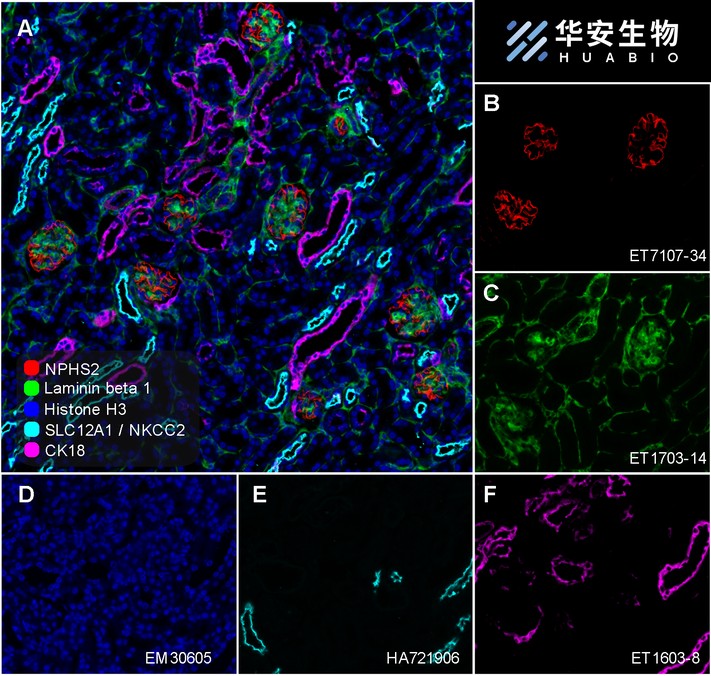
|
Fig2: Fluorescence multiplex immunohistochemical analysis of mouse kidney (Formalin/PFA-fixed paraffin-embedded sections). Panel A: the merged image of anti-NPHS2 (ET7107-34, Red), anti-Laminin beta 1 (ET1703-14, Green), anti-Histone H3 (EM30605, Blue), anti-SLC12A1 / NKCC2 (HA721906, Cyan) and anti-CK18 (ET1603-8, Magenta) on kidney. HRP Conjugated UltraPolymer Goat Polyclonal Antibody HA1119/HA1120 was used as a secondary antibody. The immunostaining was performed with the Sequential Immuno-staining Kit (IRISKit™MH010101, www.luminiris.cn). The section was incubated in five rounds of staining: in the order of ET7107-34 (1/1,000 dilution), ET1703-14 (1/1,000 dilution), EM30605 (1/500 dilution), HA721906 (1/3,000 dilution) and ET1603-8 (1/3,000 dilution) for 20 mins at room temperature. Each round was followed by a separate fluorescent tyramide signal amplification system. Heat mediated antigen retrieval with Tris-EDTA buffer (pH 9.0) for 30 mins at 95℃. Image acquisition was performed with Olympus VS200 Slide Scanner. |

|
Fig3:
Immunohistochemical analysis of paraffin-embedded human liver tissue with Mouse anti-Histone H3 antibody (EM30605) at 1/2,000 dilution. The section was pre-treated using heat mediated antigen retrieval with sodium citrate buffer (pH 6.0) for 2 minutes. The tissues were blocked in 1% BSA for 20 minutes at room temperature, washed with ddH2O and PBS, and then probed with the primary antibody (EM30605) at 1/2,000 dilution for 1 hour at room temperature. The detection was performed using an HRP conjugated compact polymer system. DAB was used as the chromogen. Tissues were counterstained with hematoxylin and mounted with DPX. |
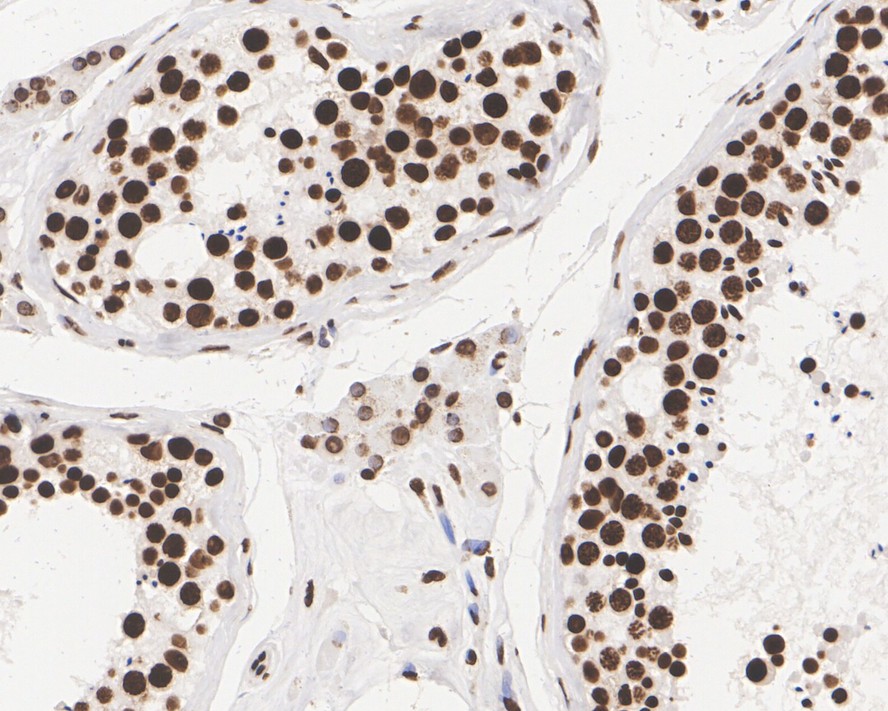
|
Fig4:
Immunohistochemical analysis of paraffin-embedded human testis tissue with Mouse anti-Histone H3 antibody (EM30605) at 1/1,000 dilution. The section was pre-treated using heat mediated antigen retrieval with sodium citrate buffer (pH 6.0) for 2 minutes. The tissues were blocked in 1% BSA for 20 minutes at room temperature, washed with ddH2O and PBS, and then probed with the primary antibody (EM30605) at 1/1,000 dilution for 1 hour at room temperature. The detection was performed using an HRP conjugated compact polymer system. DAB was used as the chromogen. Tissues were counterstained with hematoxylin and mounted with DPX. |
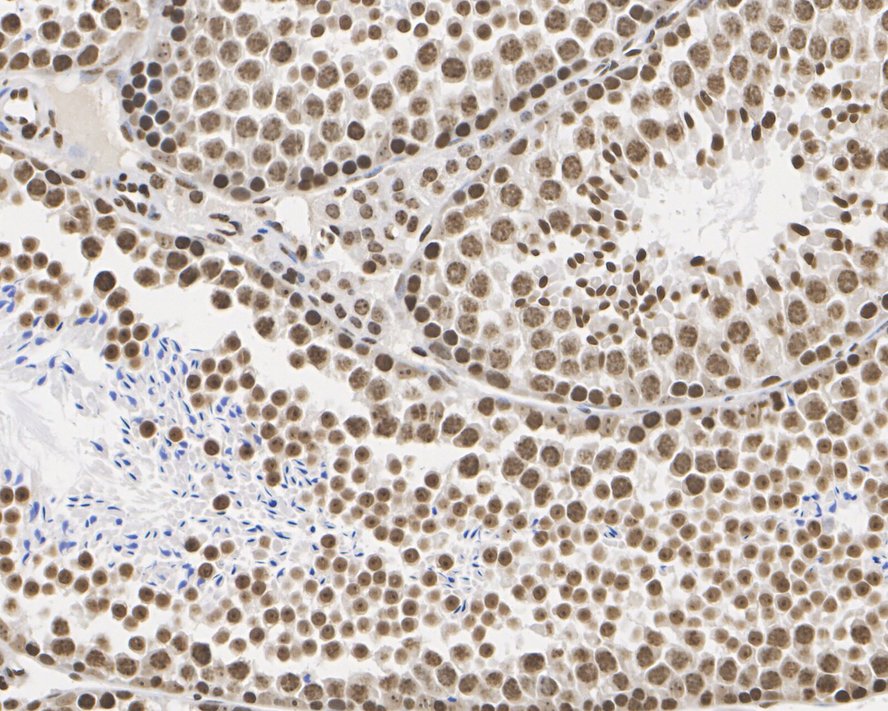
|
Fig5:
Immunohistochemical analysis of paraffin-embedded mouse testis tissue with Mouse anti-Histone H3 antibody (EM30605) at 1/2,000 dilution. The section was pre-treated using heat mediated antigen retrieval with sodium citrate buffer (pH 6.0) for 2 minutes. The tissues were blocked in 1% BSA for 20 minutes at room temperature, washed with ddH2O and PBS, and then probed with the primary antibody (EM30605) at 1/2,000 dilution for 1 hour at room temperature. The detection was performed using an HRP conjugated compact polymer system. DAB was used as the chromogen. Tissues were counterstained with hematoxylin and mounted with DPX. |
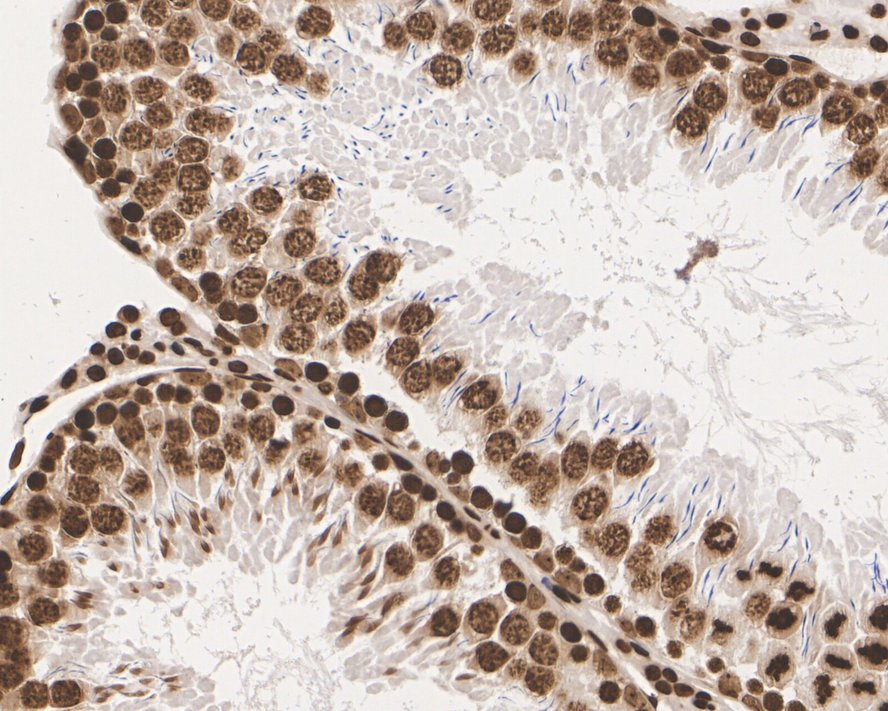
|
Fig6:
Immunohistochemical analysis of paraffin-embedded rat testis tissue with Mouse anti-Histone H3 antibody (EM30605) at 1/1,000 dilution. The section was pre-treated using heat mediated antigen retrieval with sodium citrate buffer (pH 6.0) for 2 minutes. The tissues were blocked in 1% BSA for 20 minutes at room temperature, washed with ddH2O and PBS, and then probed with the primary antibody (EM30605) at 1/1,000 dilution for 1 hour at room temperature. The detection was performed using an HRP conjugated compact polymer system. DAB was used as the chromogen. Tissues were counterstained with hematoxylin and mounted with DPX. |

|
Fig7:
Immunohistochemical analysis of paraffin-embedded rat brain tissue with Mouse anti-Histone H3 antibody (EM30605) at 1/2,000 dilution. The section was pre-treated using heat mediated antigen retrieval with sodium citrate buffer (pH 6.0) for 2 minutes. The tissues were blocked in 1% BSA for 20 minutes at room temperature, washed with ddH2O and PBS, and then probed with the primary antibody (EM30605) at 1/2,000 dilution for 1 hour at room temperature. The detection was performed using an HRP conjugated compact polymer system. DAB was used as the chromogen. Tissues were counterstained with hematoxylin and mounted with DPX. |
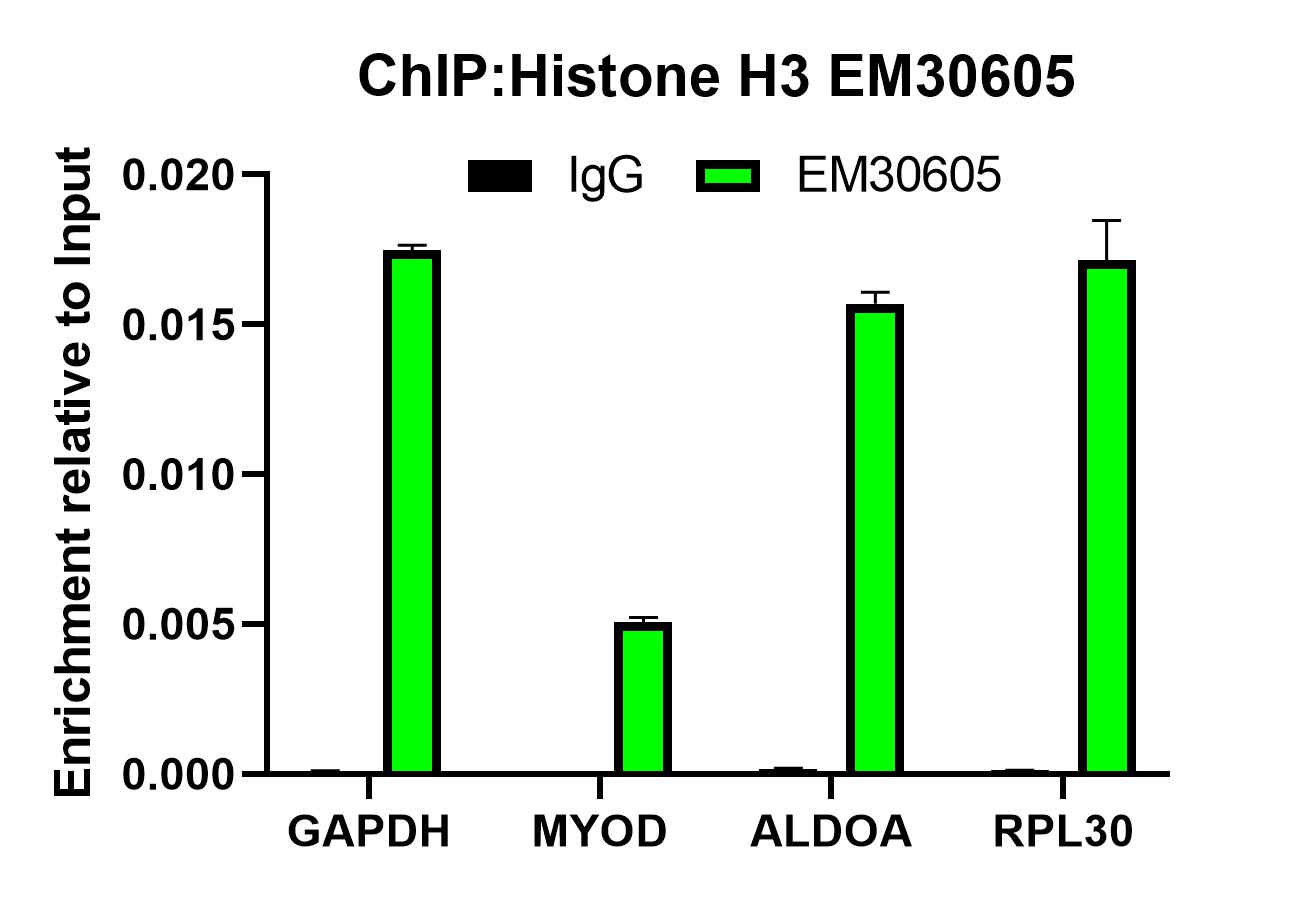
|
Fig8: Chromatin immunoprecipitations were performed with cross-linked chromatin from HeLa cells with Histone H3 (EM30605) or Normal Mouse IgG according to the ChIP protocol. The enriched DNA was quantified by real-time PCR using indicated primers. The amount of immunoprecipitated DNA in each sample is represented as signal relative to the total amount of input chromatin, which is equivalent to one. |
Note: All products are “FOR RESEARCH USE ONLY AND ARE NOT INTENDED FOR DIAGNOSTIC OR THERAPEUTIC USE”.